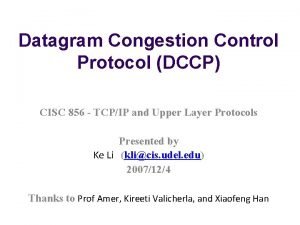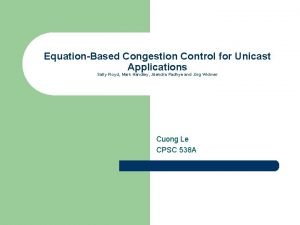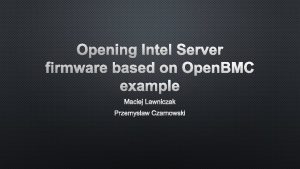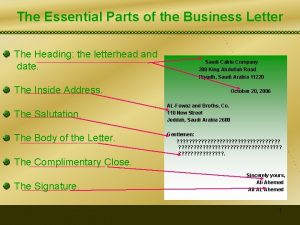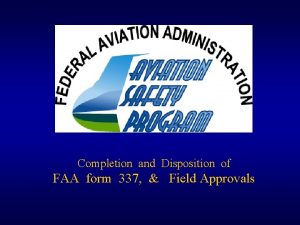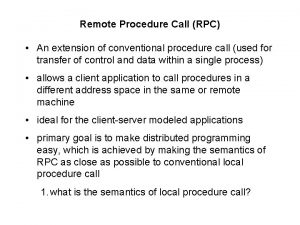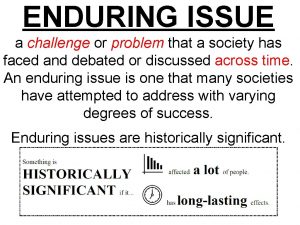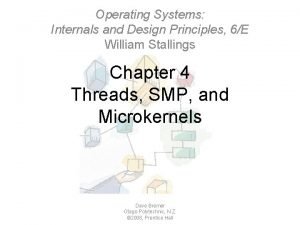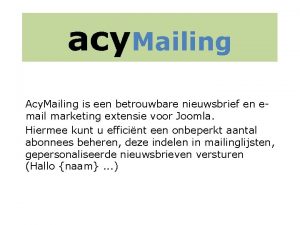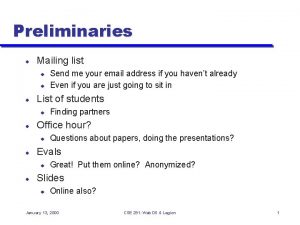DCCP Issues From the Mailing List Sally Floyd











- Slides: 11

DCCP: Issues From the Mailing List Sally Floyd, Eddie Kohler, Mark Handley, et al. DCCP WG March 4, 2004

Quotes from the Mailing List: • "Real Time apps have no interest in being 'fair'. ” • "Don't expect people like XXX to be happy with the 'you must fit in to TCPs view of the world' when most of their real-time applications are already being good citizens (by not sending 'all they can' when they don't have to). ” – [Referring to a silence-suppressed, CBR, 4 Mbps video stream!] • "Maybe some codecs of today, which were designed assuming a Qo. S enabled network, cannot make use of TRFC or DCCP. " • "TCP is broken. Nowhere is it written that TCP=best effort. "

Background assumptions (ours): • DCCP and best-effort traffic: – DCCP with best-effort service does not necessarily meet the needs of all apps. – In fact, best-effort service does not necessarily meet the needs of all apps. – DCCP is intended to solve the best-effort problem, not the Qo. S problem. – We believe that in the long run DCCP offers better performance than UDP to applications (e. g. , ECN, NAT traversal, etc. )

More Background Assumptions: • The IETF doesn't control what is deployed in the Internet. – The IETF controls what is standardized in the IETF. – The current IETF will not standardize transport protocols for best-effort service that do not have adequate end-to-end congestion control.

Issue: Steady-state fairness with TCP? • RFC 2914, Congestion Control Principles, September 2000, BCP. – Preventing congestion collapse. – Sharing bandwidth reasonably fairly with TCP.

Issue: Slow-Start • CBR app writers don't want to slow start –. . . after idle periods –. . . ever • CBR app writer perceptions [NB not direct quotes] – "We're sending at a low rate so why bother? " – Idle periods: "We're benefitting the network by going idle, why penalize us by forcing slow start after a quiet period? " – "Our traffic is more financially valuable to ISPs so congestion rules don't apply” – "TCP must be fixed [to be friendlier to CBR apps]"

Issue: Slow-Start • CCID 3 specifies initial rates of 4 pkts/RTT. – Recommends investigating initial rates of 8 ptks/RTT for small packets. • For CBR apps with higher rates, this means that some initial packets could be ‘dropped’ by DCCP. • Best-effort traffic with higher initial rates? – My own view: Explicit feedback from routers is required. – E. g. , Quick-Start, expired draft-amit-quick-start-02. txt. – You could help make this happen!

Issue: Limitation of at most doubling the sending rate • Thread triggered by earlier user guide suggestion: – Send 2 x your nominal rate to avoid: • getting penalized by "greedy" TCPs • slow start after idle periods • But TFRC isn’t penalized by TCP flows: – Transmit rate limited by *loss rate* not current rate. • The limitation of at most doubling the sending rate remains (above a minimum rate): – A problem for bursty apps, instant-on apps, silence suppression.

Issue: Slow-Start after Idle • Proposal: Faster Start – Initial rate 8 pkts/RTT (instead of 4). – Quadruple rate each RTT up to previous rate (instead of doubling). – Until a drop or mark. – This needs further investigation. • Implementation experience about slow-start problems will help.

Issues: apps with fixed rates, or a small number of possible rates, or limited to downshifting. • Email: For some apps, users prefer fixed rates. • DCCP can be used by fixed-rate apps. – Modulo slow-start, restart-after-idle issues. – DCCP will send at a sending rate allowed by the overall packet drop rate. – As always, implementation experience is needed. • Proposal: for the apps above, DCCP could sometimes send as much as twice the “allowed” sending rate? – This requires a new CCID, and some further work.

Issues: CBR flows • An alternative for CBR flows: – Monitor the steady-state packet drop rate, stop sending when the drop rate is too high. – "IAB Concerns Regarding Congestion Control for Voice Traffic in the Internet”, approved as an RFC.
